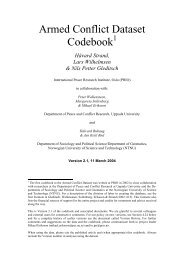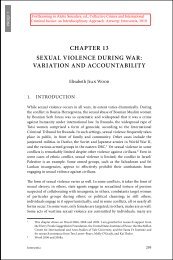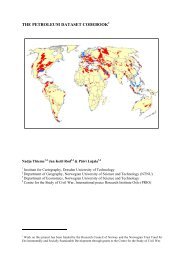Peacemaking Is a Risky Business - PRIO
Peacemaking Is a Risky Business - PRIO
Peacemaking Is a Risky Business - PRIO
Create successful ePaper yourself
Turn your PDF publications into a flip-book with our unique Google optimized e-Paper software.
190 ‘<strong>Peacemaking</strong> <strong>Is</strong> a <strong>Risky</strong> <strong>Business</strong>’mented and expanded. Norwegian involvement became massive and comprehensive.Norway – ‘the modest hero of the Oslo effort’ – continued to find and carry out bothits old and new roles as the ever-available helper and fixer, always eager to help solveproblems and keep the peace process alive. 179Terje Rød Larsen and Mona Juul continued to be the main operators of the Norwegianpeace team, but with 100% backing from eager and devoted politicians in theministry of foreign affairs. Norwegian involvement in the peace process was basicallymanaged by politicians, with all of the decisions and signals coming from the very topof the ministry, leaving the bureaucrats little room for influence and manoeuvre. StateSecretary Jan Egeland had recovered from his setbacks under Holst, and was fromJanuary 1994 back in his old, active engagement role under Godal. Within the ministryitself, Egeland was the one who actually ran the Norwegian peace project in theMiddle East. In addition, Foreign Minister Godal – and occasionally even Prime MinisterGro Harlem Brundtland – was always ready to make an effort if someone in theMiddle East called for this – which the parties in the Middle East did.Naturally, the rifts between the <strong>Is</strong>raelis and the Palestinians could not always behealed by the Oslo spirit, creative formulations and cosy settings. Hard facts and realitieshad to be sorted out and difficult problems solved – in Taba and in other placeswithout particularly ‘cosy’ atmospheres. In principle, after the signing of the OsloAgreement, the <strong>Is</strong>raelis and the Palestinians could freely communicate directly witheach other and do their negotiating themselves. Delegations from the two sides tookcare of the various items under discussion. But the Norwegians were still at hand,ready to help if the <strong>Is</strong>raelis and Palestinians wanted them to. The Norwegians wereconstantly briefed by both parties about the progress – or, more often, lack of progress– in the process. Over and over again, the peace process ran into trouble. In particular,Terje Rød Larsen was still needed and called upon in order to ‘navigate through ... crisis’.180 He and the rest of the Norwegian peace team were always ready for new assignments.The Norwegians used every opportunity to get things moving and to clear as manyobstacles out of the way as possible, working tirelessly backstage. However, problemswith the lack of political progress began to appear immediately. As early as the beginningof November 1993, the Palestinians were growing increasingly frustrated andimpatient. The Norwegians – and Foreign Minister Holst in particular – were neededto sort things out. The Palestinians had many problems.In mid-November, as discussed above, Holst travelled to Tunis in order to help Arafatsort out the principles for the recipient structure and to deal with the issue of a Palestinianpolice force, but these were not the only areas requiring Norwegian help. Theleader of the Palestinian Gaza–Jericho delegation, Nabil Shaath, repeatedly called forNorwegian intervention in the political arena, the area the parties were supposed tohandle themselves. The Gaza–Jericho negotiations were in a state of crisis, Shaath179 Savir 1998, p. 82.180 Savir 1998, p. 123.
















